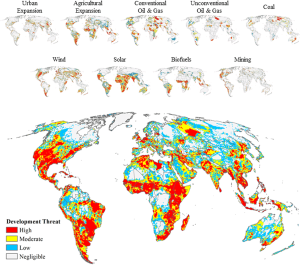 Author(s): James R. Oakleaf,Christina M. Kennedy,Sharon Baruch-Mordo, Paul C. West, James S. Gerber, Larissa Jarvis and Joseph Kiesecker
Author(s): James R. Oakleaf,Christina M. Kennedy,Sharon Baruch-Mordo, Paul C. West, James S. Gerber, Larissa Jarvis and Joseph Kiesecker
Title: A World at Risk: Aggregating Development Trends to Forecast Global Habitat Conversion
Year: 2015
In: PLOS ONE, DOI: 10.1371/journal.pone.013833. Published online: 7 October 2015
Pages: 25 pages.
Publication type: open access journal article
Language: English
Source: http://journals.plos.org/plosone/article?id=10.1371/journal.pone.0138334
Abstract:
A growing and more affluent human population is expected to increase the demand for resources and to accelerate habitat modification, but by how much and where remains unknown. Here we project and aggregate global spatial patterns of expected urban and agricultural expansion, conventional and unconventional oil and gas, coal, solar, wind, biofuels and mining development. Cumulatively, these threats place at risk 20% of the remaining global natural lands (19.68 million km2) and could result in half of the world’s biomes becoming >50% converted while doubling and tripling the extent of land converted in South America and Africa, respectively. Regionally, substantial shifts in land conversion could occur in Southern and Western South America, Central and Eastern Africa, and the Central Rocky Mountains of North America. With only 5% of the Earth’s at-risk natural lands under strict legal protection, estimating and proactively mitigating multi-sector development risk is critical for curtailing the further substantial loss of nature.
Extract: Planning for the future: proactive mitigation
With development increasingly encroaching into more remote and previously undisturbed areas, it is critical that international corporations, governments and conservation organizations collaborate to reduce and minimize potential future impacts on remaining habitats. We propose that regulations for development siting and impact mitigation, as well as the implementation of land use planning, should target priority regions where development could threaten significant proportions of natural areas, such as the 224 ecoregions with the highest potential conversion of natural habitat (Fig 4B). These ecoregions could be further prioritized based on high biodiversity (e.g., refs [23–25]) and/or ecosystem service values (e.g., ref [26]). Once a priority region is identified, we suggest following analyses similar to ours that delineate natural areas at greatest risk to cumulative development threats, but to perform such analyses at finer (landscape) scales using more refined biodiversity data (e.g., as done in ref [27]). While our analysis provides an important global perspective, data uncertainties limit its use for most conservation interventions and mitigation planning efforts.
Implementation of mitigation requirements should also be conducted at landscape scales and include procedures for proactively evaluating the compatibility of proposed development with conservation goals to determine when impacts should be avoided and when development can proceed (e.g., as done in ref [21]). Given the expansive scale of expected impacts from a variety of sectors, developers will need to compensate for residual impacts through the use of biodiversity offsets. Also known as set-asides, compensatory habitat, or mitigation banks, biodiversity offsets are a tool for maintaining or enhancing environmental assets in situations where development is sought despite negative environmental impacts. To meet the need for additional investment in biodiversity offsets significant improvement of regulatory oversight will be needed [28].
Without strong oversight and proactive planning, countries containing high risk areas which also have weak governance and low levels of environmental protection are likely to suffer severe environmental damage [29]. In contrast, where environmental regulations are adequately enforced, impacts on biodiversity can be avoided and properly offset [21,27]. Opportunities for improvement include expanding, strategically locating, and enforcing global networks of protected areas in high-risk areas [18,30]; extending mitigation regulations to countries that currently lack them; and strengthening compliance where implementation of mitigation is weak [28]. In the interim, poorly performing national policies can be supplemented by the reinforcement of the mitigation hierarchy and adhering to planning mandates by multilateral development banks. For example, more than 70 Equator Principle financial institutions currently base their requirements on the International Finance Corporation’s (IFC) Performance Standards, which require that the projects they finance adhere to the mitigation hierarchy with regard to biodiversity and ecosystem service impacts [31]. In Africa and South America where development risk is high, the African and Inter-American Development Banks can provide leverage to ensure development projects avoid critical habitats and minimize and reduce impacts to less-critical areas and compensate where necessary.
While global agriculture, energy and mineral development are inevitable in the coming decades, their negative environmental impacts can be better managed. We suggest that using tools that cumulatively consider all current and future development threats, even when there are uncertainties and inaccuracies, will facilitate and advocate for more strategic and proactive development planning. This will allow for the world to better benefit from economic growth while also maintaining functioning ecosystems and critical biodiversity. It will however be critical to act proactively before development plans are cemented, and it becomes too late for these regions and biomes at greatest risk.
